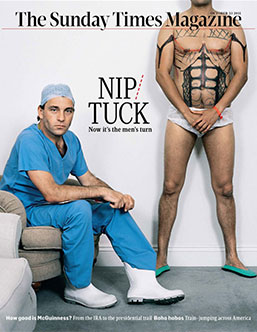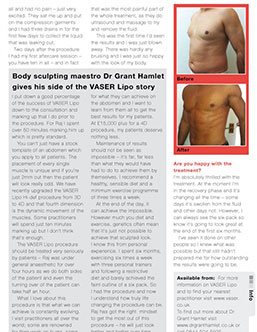
A compression garment is designed to reduce swelling and assist in the healing process after liposuction. While liposuction is a minimally-invasive procedure that doesn’t even require sutures, it can result in significant swelling, also called oedema, as well as other side effects. Though some swelling is completely normal during the healing process, it needs to be managed to minimise the risk of complications such as fluid buildup and contour and surface irregularities. (1)
Dr. Hamlet and the cosmetic surgeons of Dr. Grant Hamlet in London, specialise in highly advanced VASER liposuction techniques which incorporate ultrasound technology to safely and effectively liquify fat cells for easier extraction. As a world-renowned VASER expert, Dr. Hamlet offers VASER professional training to other doctors, making Dr. Grant Hamlet the premiere choice for body contouring. To find out if liposuction is right for you, call us at (0207) 127 4377 or book a consultation online today.
Contents
Table of Contents
ToggleWhat Causes Swelling After Liposuction?
Swelling is a completely normal reaction to an invasive procedure. In essence, swelling is the result of an inflammatory response by the immune system, since it interprets surgical incisions and modifications as injuries. During liposuction, blood vessels in the fat and surrounding tissues are disrupted by the suctioning cannula. Even when well controlled, the presence of blood in tissues causes an inflammatory reaction. During this inflammatory response, cells produce proteins called cytokines that trigger the release of immune cells to fight infection. Once the surgery is over, the inflammatory response causes adjacent blood vessel membranes to become more permeable and allow blood plasma and other fluids to enter the interstitial space, the tiny areas between blood vessels and surrounding tissues, causing swelling. (2)
Blood plasma is simply blood without the proteins within it, so it looks slightly yellow. Plasma is part of what makes up serous fluid, the substance that causes the swelling itself. Serous fluid also contains lymphatic fluid, a substance that passes through the entirety of the lymphatic system that is responsible for immune responses. (3)
So swelling is a natural and beneficial reaction, but it can be uncomfortable. And, if this process isn’t adequately controlled with a compression garment after liposuction, complications can arise.
Using a Compression Garment Reduces Complications
Oedema is a natural response, but too much of it can interfere with the results of liposuction. Compression garments are able to significantly reduce the risk of complications from liposuction, such as:
- Seroma: When serous fluid builds up in one area under the skin, it is called a seroma. Seromas form after liposuction because of the empty spaces that are created when the fat is removed. When severe seromas form the required treatment involves taking out the excess fluid through a needle (aspiration) and applying compression.
- Haematoma: This is an accumulation of blood under the skin in one area. While small haematomas can be left alone, larger ones may need to be aspirated and compressed.
- Bruising: Bruising is one of the most common effects of liposuction- it is a less severe form of haematoma. Though it’s unpreventable, following compression guidelines will significantly reduce the duration of your bruising after the procedure.
- Surface Irregularities: Compression can help the area of liposuction heal smoothly and promote healthy skin retraction. (1) Sometimes, bulges and depressions in the skin can resolve within a few weeks of compression and a few more months of healing.
- Asymmetry: A quality compression garment can distribute equal compression across one area. Compression can also help arms and legs heal the same as each other.
- Deep Vein Thrombosis (DVT): DVT is a serious, extremely rare condition that occurs after surgery. It is when a blood clot reaches a deep vein in the body, usually a vein within the leg. Properly elevating the legs and the use of compression stockings can greatly reduce the risk of DVT. (1)
- Pain: By reducing the amount of serous fluid buildup, a compression garment can minimise discomfort during recovery.
Choosing a Compression Garment
Dr. Hamlet ensures that every liposuction patient receives a prescription compression garment that fits them perfectly, provides adequate, even compression, and is high-quality material.
After liposuction, we will provide the compression garment right away. You will have to wear it for the next 4 to 6 weeks. (1) As the swelling subsides within a few days, you will need another smaller garment that will continue to fit you snuggly. The ideal garment shouldn’t cause any pain, shouldn’t fold, and should consistently lie flat against your body. The best garments are made from nylon, elastic, or another strong, synthetic material.
Depending on your procedure, you may have to wear your garment full-time for at least 2 weeks, then gradually lessen the amount of time over the next 3 weeks. During the period in which you’ll have to wear your garment full-time, it’s crucial that you only take it off for bathing purposes. You should also use that time to change your bandages.
It’s important to check in with your doctor during your follow-up appointments to ensure that the garment fits correctly, your recovery is going as planned and that the swelling is reducing steadily. After roughly 3 months, the tissue tends to soften, and not feel hard and swollen. (1)
Other Tips for Reducing Swelling after Liposuction
First and foremost, it’s important to keep your liposuctioned area clean with new bandages daily. By examining your treatment area, you can watch out for any signs of infection or increased swelling. Although compression garments serve a vital function, there are other steps you can take to help your body drain excess fluid. A healthy diet is one of the many keys to healing well. Studies show that a diet high in protein, iron, zinc and a wide variety of vitamins (including A, B, C, and D) promotes healing. (4) You should make sure that you get plenty of rest for the first couple of days. As soon as you are able to, get some light and short exercise to increase blood circulation for better wound healing. Strenuous workouts can be resumed after about 3 to 4 weeks.
Liposuction Procedures
As a liposculpture specialist, Dr. Hamlet offers his patients the latest in liposuction technology. Each procedure offers unique benefits and employs the safest and most effective techniques today:
VASER High-Definition Liposuction
VASER is a highly sophisticated form of liposuction because it utilises ultrasound energy to loosen fat from surrounding tissue. With this method, electromagnetic energy turns into vibration, which is then converted into thermal energy. VASER levels can be adjusted; it can adapt to more delicate areas and larger, more voluminous areas. This type of lipo can tone and sculpt the chest, thighs, abdomen, arms, and back. With VASER techniques, the muscles can be enhanced by leaving a thin layer of fat overlying them.
VASERsmooth
Although not a liposuction procedure, VASERsmooth works to reduce the dimples caused by cellulite. Fat cells are connected to the skin through fibrous strands called septae. As the fat cells grow larger, they protrude outward, while the septae pull the skin downward. Through a 4mm incision, the VASERsmooth device cuts through the septae and emulsifies fat so that the skin can retract and provide a smooth, cellulite-free appearance.
Personal Consultation
During a personal consultation, a cosmetic surgeon Dr. Grant Hamlet will review your medications, conduct blood tests, and talk about the aesthetic goals you want to achieve through liposuction. We will also review your medical history, any previous surgeries, and if you smoke regularly. With a thorough consultation, we will walk you through our knowledge of liposuction, the process of using a compression garment, and the incredible results that wait for you at the end of your recovery! You can contact us online or call (0207) 127 4377 to book your appointment.
Cost of Liposuction in London, England
The cost of your liposuction procedure will depend on the type of liposuction method you opt for, the size of the treatment area, and the extent of your changes. With a personal consultation, we can guide you through your treatment with quality care, honesty, and information on your preparation and recovery.
Find out more about VASER Liposuction on Dr. Hamlet’s blog.
FAQ
Can I buy my own compression garment after liposuction?
Before buying your own compression garment, be sure to get your doctor’s approval. The ideal compression garment is stretchy, strong fabric that is snug against your skin at all times.
Can I get liposuction to lose weight?
Although you may lose weight after liposuction, it’s not a weight-loss procedure. In order to get liposuction, you should be close to your ideal weight and looking to sculpt areas of your body with unwanted fat deposits.
When will I notice the results of liposuction?
The final results will appear around 3 months after your liposuction procedure.
References
- Dixit VV, Wagh MS. Unfavourable outcomes of liposuction and their management. Indian Journal of Plastic Surgery : Official Publication of the Association of Plastic Surgeons of India. 2013;46(2):377-392. doi:https://www.ncbi.nlm.nih.gov/pmc/articles/PMC3901919/
- Vaughan-Shaw P, Saunders J, Smith T, King A, Stroud M. Oedema is associated with clinical outcome following emergency abdominal surgery. The Annals of The Royal College of Surgeons of England. 2013;95(6):390-396. doi:https://doi.org/10.1308/003588413×13629960046552
- Kazzam ME, Ng P. Postoperative Seroma Management. PubMed. Published 2022. https://www.ncbi.nlm.nih.gov/books/NBK585101/
- Barchitta M, Maugeri A, Favara G, et al. Nutrition and Wound Healing: An Overview Focusing on the Beneficial Effects of Curcumin. Int J Mol Sci. 2019;20(5):1119. Published 2019 Mar 5. doi:10.3390/ijms20051119











